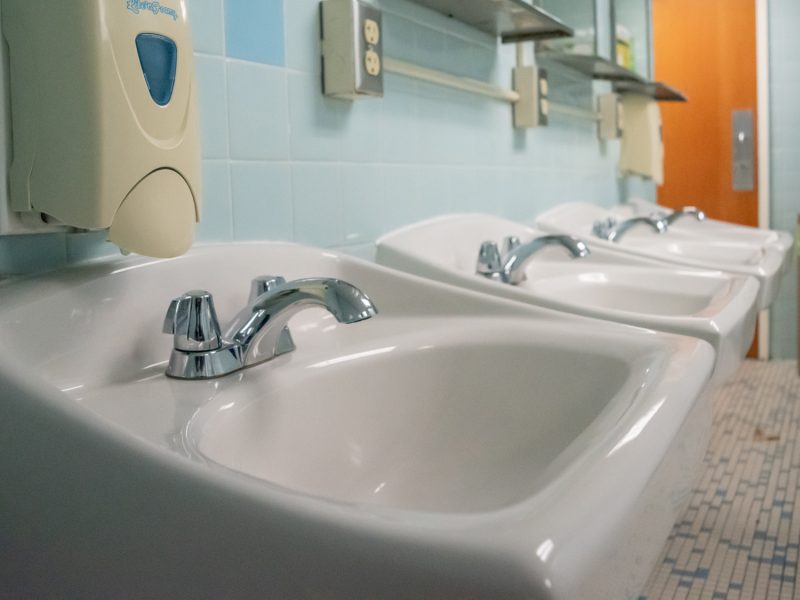When Mandy Stussman was in high school, she read Michelle Alexander’s “The New Jim Crow: Mass Incarceration in the Age of Colorblindness” which she said helped develop her perspective on injustice in the prison system.
“This is not a far away problem — [prisons are] everywhere,” the junior sociology major said.
Prisoners in many states across the nation coordinated a national prison strike on Sept. 9 to protest free prison labor. Despite a failed Sept. 10 rally in College Park to support the initiative — only four people showed up — University of Maryland students are making an effort to spread the word on prison abolition, which seeks to reduce or eliminate prisons and institute more humane systems.
Nathan Brandli, a 2016 graduate of this university and an African-American studies department general associate, has been working with a student group he started on the campus — Organization of Prison Abolitionists — for about a year and has about 10 active members. He’s also collaborated with the group Release Aging People in Prison, a national organization with chapters in the DMV area, and is trying to start a re-entry or pre-release program at Maryland Correctional Institute Jessup.
Junior English major Brandon Johnson has also gotten involved in the cause, including through co-networking with OPA.
“There’s a lot of fire in the group, just not a … broad base of participants,” Johnson said. “I feel like it can really go a long way.”
Chris Bangert-Drowns helped plan a teach-in, which discussed the history of prisoner resistance in the United States and the state’s broken parole system, on Sept. 9, the day before the protest was supposed to happen. He is also a member of the Student Labor Action Project, which allows him to mobilize that club to support OPA.
For the senior economics major, the mass incarceration system is “a method of social control of black communities.” Blacks and Hispanics comprised 58 percent of all prisoners in 2008, according to the NAACP.
“It’s … important to not exist within a siloed activist group,” Bangert-Drowns said.
For Stussman’s Arts Scholars capstone project, she researched the war on drugs, which led her to learn about its contributions to mass incarceration. Among the things she learned is that this university purchases furniture from Maryland Correctional Enterprises, a division of the state’s Department of Public Safety and Correctional Services.
“A lot of people are surprised by the information,” Stussman said. “I want to just scream it to everybody — get everybody to realize that this is a real thing that’s happening.”
Stussman considers the use of prisoners to supply furniture to outside entities as a sign that slavery “is alive and well,” she said, “and if we’re against slavery the way it happened before 1850, we have to be against slavery the way it’s happening now.”
A state or state-funded entity is required to “buy supplies and services from Maryland Correctional Enterprises” as well as from Blind Industries and Services of Maryland, according to the 2015 Maryland Code for State Finance and Procurement. The vast majority of furniture at this university comes from MCE.
Tom Hickey, the University System of Maryland’s director of procurement and real property initiatives, indicated that MCE has two main purposes: teaching the inmates job skills and cutting down expenses for those who purchase from the company. MCE is a 100 percent self-supporting agency.
Inmates are paid approximately $150 per month depending on factors such as incentive, as well as “good time” credits off their time if they’re not serving a life sentence, Department of Public Safety and Correctional Services media relations specialist Gerard Shields wrote in an email.
“I did a tour two years ago [of] the women’s facility in Jessup and [the inmates] train service dogs for disabled individuals,” Hickey said. “There’s a number of different areas where they work.”
In January, the USM Student Council went to visit MCE in Jessup because the group was under the impression that inmates were working under substandard conditions and that they didn’t want to be in the program, said Council President Gayon Sampson.
“It would do great service to our state to look into this program and see what we can do better to help those who are incarcerated so that when they come out, they have a better chance of becoming rehabilitated and become productive members of society,” Sampson said.
People tend to not know exactly what prison abolition entails, Johnson said.
“We don’t mean abruptly … the abolition of all incarceration facilities and any way of addressing crime or criminal activity in society,” Johnson said. “Instead of looking at punishment as the base, we want to look at root causes.”
He named poverty, mental health, lack of education, employment and housing opportunities as some of these root causes.
“It doesn’t matter what they’ve done. I don’t care if somebody’s killed someone or done something pretty brutal to another human being,” Brandli said. “Maybe they’re not changeable and … can’t have complete freedom because they’re a danger to someone else, but we’re not going to just try and cause [them] as much misery as possible.”



